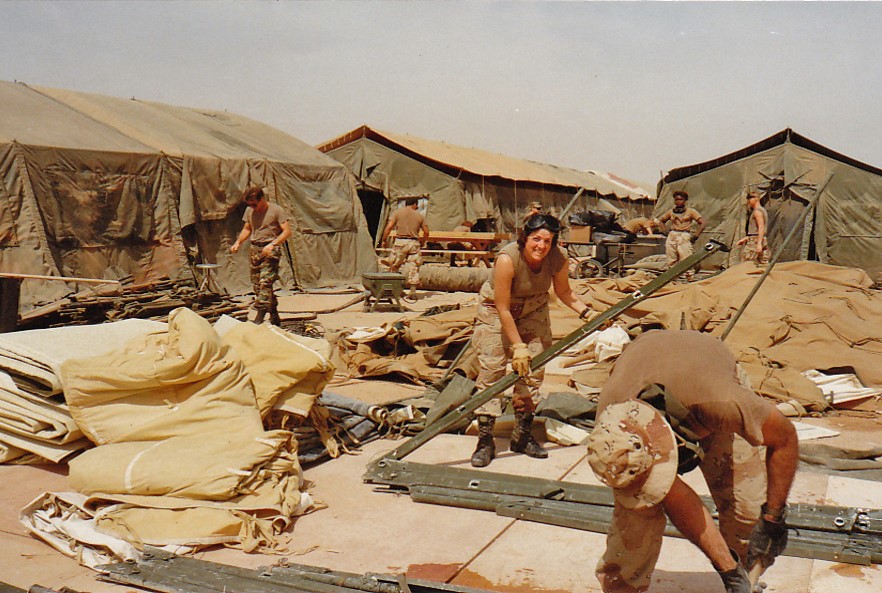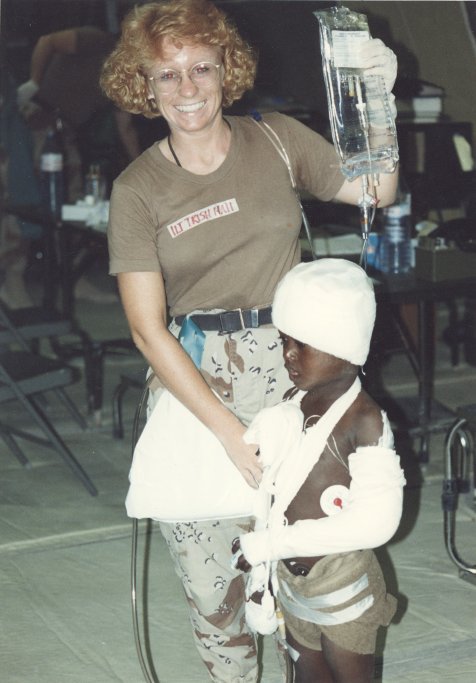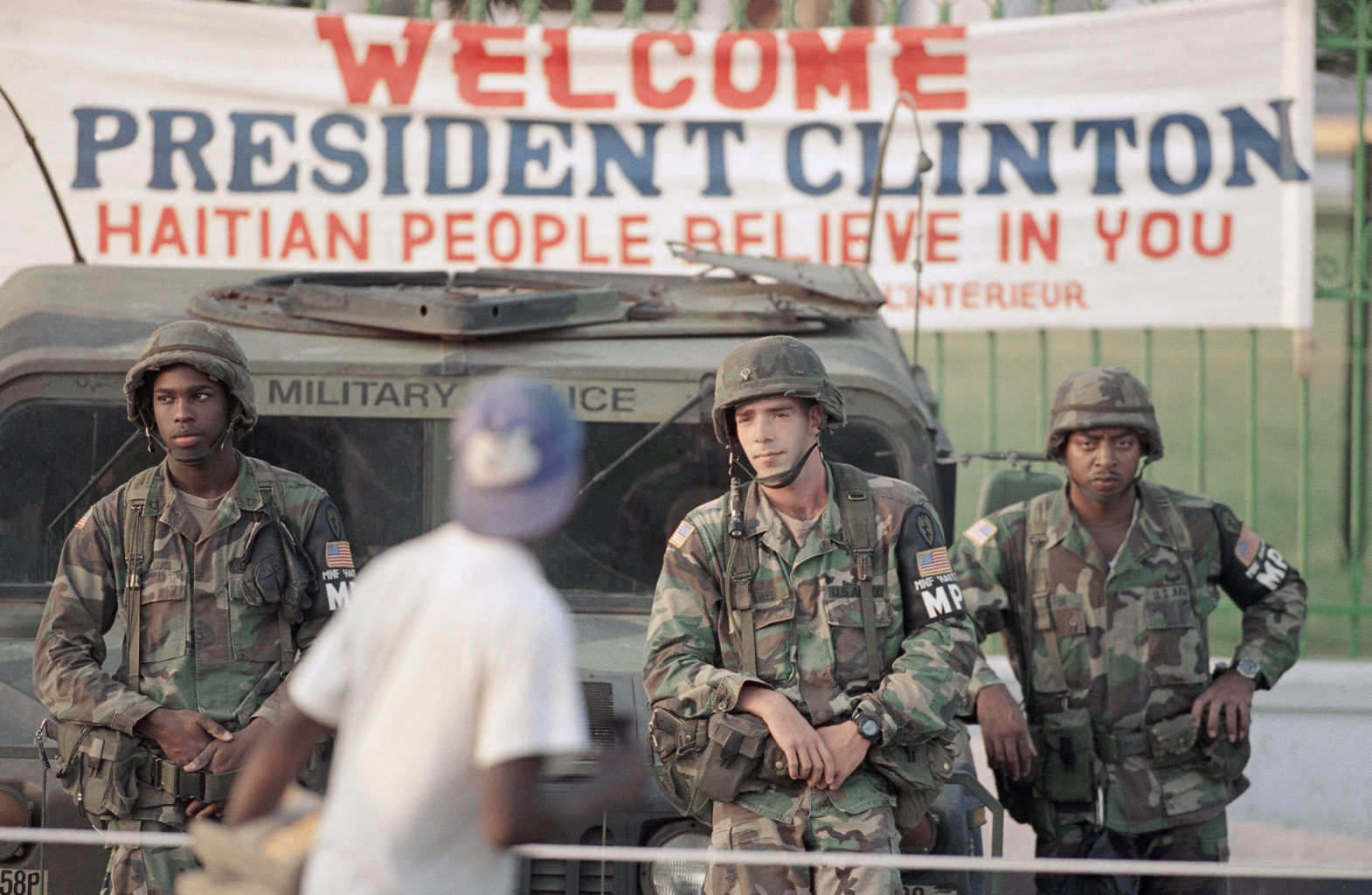Highlights in the History of the Army Nurse Corps, 1990 to 2000
In August 1990, Iraqi armed forces invaded and occupied the
country of Kuwait. At the request of the Saudi Arabian
government, the United States deployed combat troops, including U.S. Army ground forces, to aid
in the defense of Saudi Arabia, which neighbors Kuwait, in an action
called Desert Shield/Storm.
 The campaign required 13,580 operating beds in 44 field
hospitals in four countries, including 17 Army Reserve and 11 National Guard hospitals.
The campaign required 13,580 operating beds in 44 field
hospitals in four countries, including 17 Army Reserve and 11 National Guard hospitals.  Army nursing deployment for this conflict differed from the
Vietnam War in that two of every three of the
Army nursing deployment for this conflict differed from the
Vietnam War in that two of every three of the  2,200 nurses were from the guard or reserve. In this massive deployment, unprecedented for its
speed, these health care professionals were instrumental in standing up the new
Deployable Medical Systems (DEPMEDS) field hospitals.
2,200 nurses were from the guard or reserve. In this massive deployment, unprecedented for its
speed, these health care professionals were instrumental in standing up the new
Deployable Medical Systems (DEPMEDS) field hospitals.
Throughout this decade, Army nurses played an important role in
primary care. Nurse-managed clinics and Family Nurse Practitioners had
significant impact on patient care in the outpatient setting. These healthcare
professionals participated in innovative remote patient monitoring via “electronic
house calls” for chronic illnesses.
The talented cohort of Army Nurse Corps officers competed with other members of the Army
Medical Department (AMEDD) for command positions. Selection of officers for branch immaterial command was a testament to how these nurses were
leader-developed. Providing, managing, and leading in the delivery of nursing
care effectively prepared Army nurses to serve at all levels of the
organization.
ANC officers were active
throughout the world both in armed conflicts and humanitarian, peacekeeping,
and  nation-building endeavors. After the fall of the Somalian government in 1991, Operation Restore Hope was mounted as a
humanitarian effort in the resulting civil unrest and near-starvation of the people. Over the course
of 13 months, 3 field hospitals were sequentially
nation-building endeavors. After the fall of the Somalian government in 1991, Operation Restore Hope was mounted as a
humanitarian effort in the resulting civil unrest and near-starvation of the people. Over the course
of 13 months, 3 field hospitals were sequentially  deployed to a mission that
quickly devolved from humanitarian aid to combat. During this deployment AMEDD personnel in the African
country cared for the largest single-day volume of combat casualties since the
Vietnam War.
deployed to a mission that
quickly devolved from humanitarian aid to combat. During this deployment AMEDD personnel in the African
country cared for the largest single-day volume of combat casualties since the
Vietnam War.
Operation Provide Promise was a humanitarian relief
operation in Bosnia and
Herzegovina during the Yugoslav Wars. From 2 July 1992 to 9
January 1996 was the longest-running humanitarian airlift in history. Army
nurses served in several hospitals sent consecutively to provided
health care and 30-day patient holding capability for the 20,000-strong United Nations
forces. Nearly 46,000 outpatient cases were treated, more than 2,000
patients admitted, and more than 1,200 surgeries performed.
 As a result of instability in Haiti in September
1994, a multinational force deployed to reestablish order. Army nurses
supported the mission during several field hospital rotations in Haiti as well
as refugee care in Guantanamo Bay Cuba, and Suriname. They were confronted with
a populace that is medically underserved. Untreated and advanced infections,
broken bones that did not heal properly, and maggots in dirty wounds required their
flexibility, creativity, and expert skills. The traditional use of field-expedient skills achieved many positive patient outcomes.
As a result of instability in Haiti in September
1994, a multinational force deployed to reestablish order. Army nurses
supported the mission during several field hospital rotations in Haiti as well
as refugee care in Guantanamo Bay Cuba, and Suriname. They were confronted with
a populace that is medically underserved. Untreated and advanced infections,
broken bones that did not heal properly, and maggots in dirty wounds required their
flexibility, creativity, and expert skills. The traditional use of field-expedient skills achieved many positive patient outcomes.
Photos
|
Left from top:
109th Evacuation Hospital, Alabama National Guard
Mohaamed Nur, patient on intermediate care ward of the
86th
Evacuation Hospital, Somalia. January-May, 1993
Military Police of the 25th Division, part of the multi-
national force deployed to Haiti in 1994
|
Right from top:
Assembling the 86th Evacuation Hospital DEPMEDS modules
86th Evac at King Khalid Military City, Saudi Arabia
Operation Restore Hope, Somalia,
January-May 1993, 86th
Evac Lt. Patricia Hall with a wounded Somali boy
|
Text by ANCA Historian COL (Ret.) C. J. Moore; Photos courtesy of the Army Medical Department Center of History and Heritage